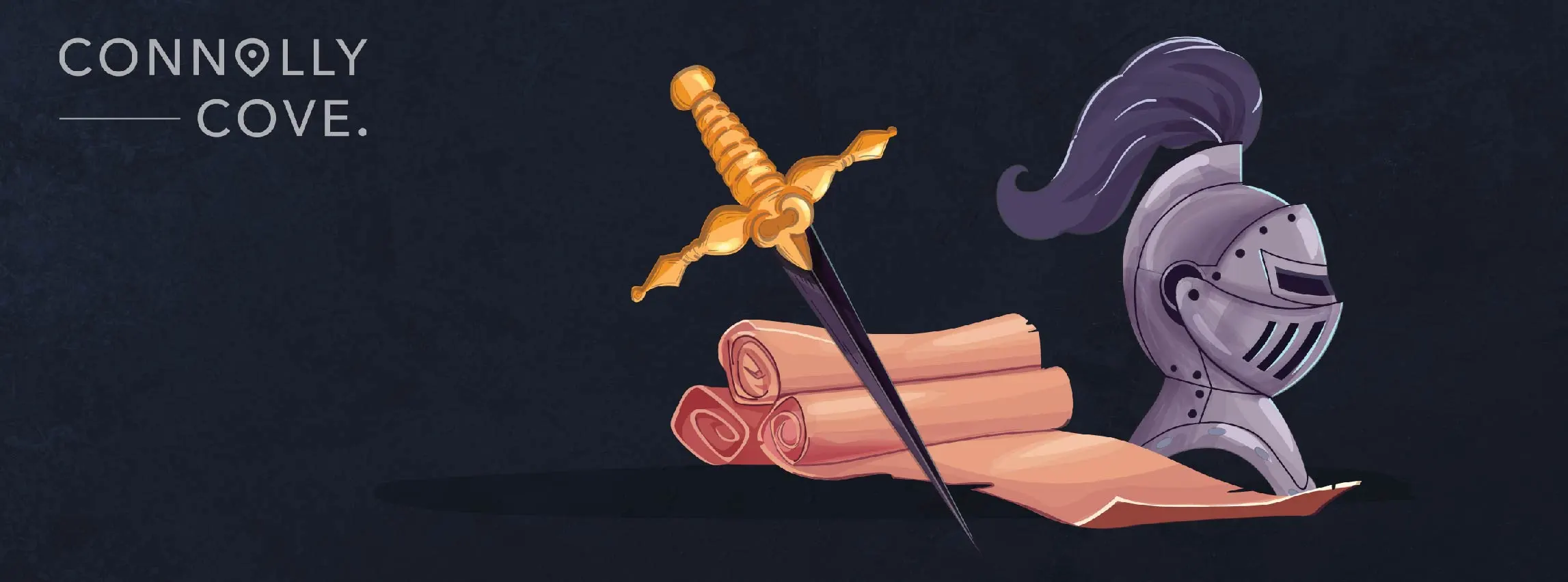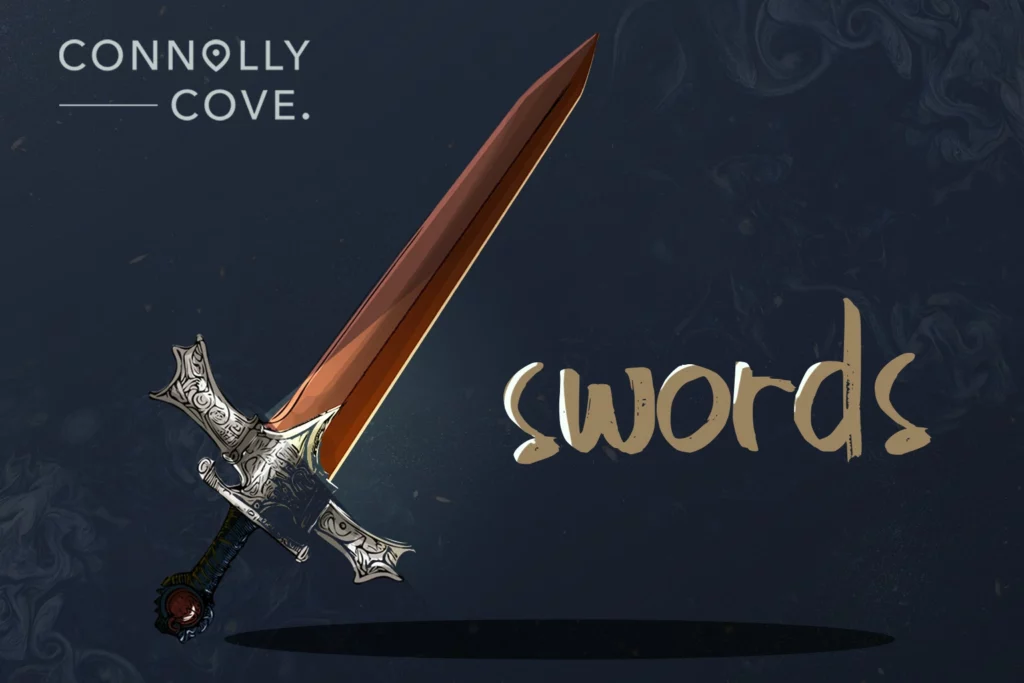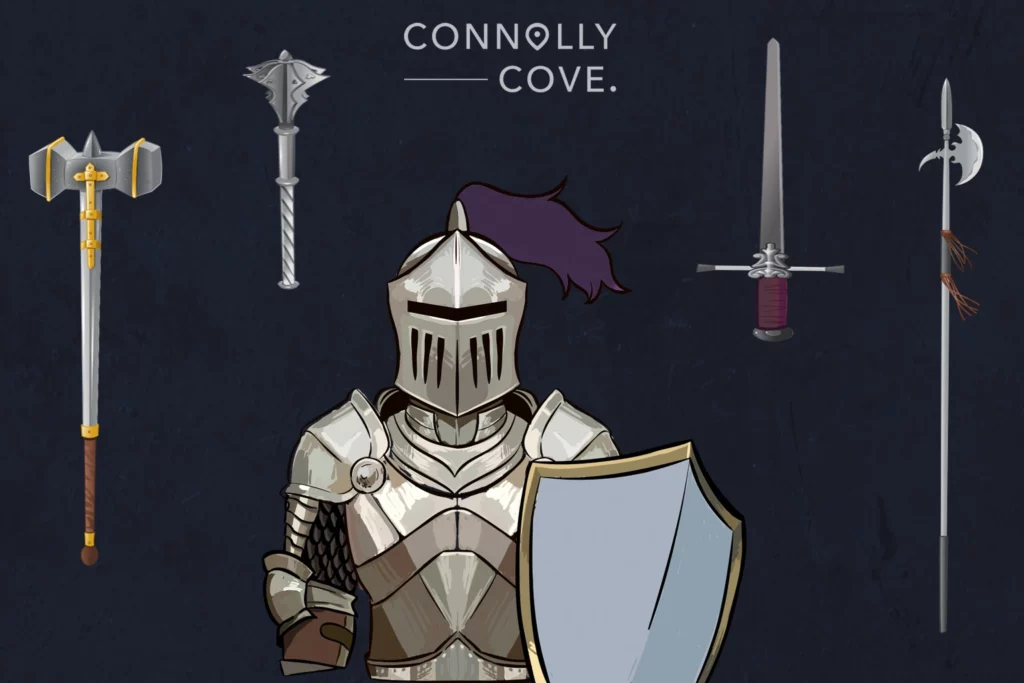7 Medieval Weapons- Simple to Complex Tools

Updated On: November 09, 2023 by Ciaran Connolly
Swords and lances were not the only weapons used in the bloody battles of the Middle Ages.
When picturing medieval European battles, we usually concentrate on the knights, glamorous noble warriors fighting with lances and swords. But Although these weapons were essential, medieval warriors beat their opponents with a collection of rough instruments.
The popularity of a weapon was based on various factors, including its effectiveness, quality and cost. However, in the middle of the fighting, a weapon’s mark on the opponent finally proved its value.
Kelly DeVries, a medieval war expert at Loyola University, states that medieval weapons rarely surpassed metal armour. “But blunt force trauma, the smashing of the bones, will incapacitate somebody.” It is not a must for the weapon to kill to be vital. It just had to draw an opponent out.
1. Swords
The sword is a long, edged piece of formed metal used in various civilisations worldwide, mainly as a thrusting or cutting weapon and occasionally for clubbing.
The word sword is derived from the Old English’ sweord’, a Proto-Indo-European root ‘swer’ meaning “to wound, to cut”.
A sword is basically made up of a hilt and a blade, commonly with one or two edges for attacking and cutting and a point for force. Swordsmanship’s basic goal and physics have lasted somewhat constant through the centuries. Still, the actual techniques differ among cultures and generations due to the differences in blade design and intent.
Unlike the bow or lance, the sword is an entirely military weapon, and that’s why it is a symbol of warfare in many cultures. The various names of swords in literature, mythology, and history reflect the high status of the weapon.
Swords can be made with single or double-bladed edges. The blade can be made straight or curved.

a. Arming Swords
The arming sword is also frequently called a knight’s or knightly sword. It is single-handedly formed in a cross sword of the High Middle Ages, commonly used between ca. 1000 and 1350, rarely used in the 16th century.
Arming swords are generally thought to be descendants of the swords of the migration time and Vikings.
The arming sword was commonly used with a buckler or a shield. Before the longsword rose to prominence in the late 13th century as a result of technological advancements, it served as the knight’s primary battle sword. Various texts and pictures express effective arming sword fighting without a shield.
Based on Medieval texts, the soldier could use his empty to grab opponents without a shield.
The arming sword was generally light, a versatile weapon that can cut and push war, and boasts typically perfect balance. Although various designs fall under an ‘arming sword’ umbrella, they are most commonly identified as single-handed double-edged swords that were meant more to cut than thrust. Most 12th-14th century blades look to range between 30 and 32-inch blades.
Arming swords, in general, began to concentrate on design forms in the late 12th century, either becoming squatter and extremely pointed or heavier and longer in design.
So, there are two separate methods of remodelling the arming sword to fight increasingly tough armour; either to make the blade heavy enough to force blunt trauma through the armour or narrow-pointed sufficient to stab it with a strong push.
The arming sword is a typical weapon in period artwork, and various surviving examples exist in museums. In fact, the first longswords were smaller than two-handed arming swords, but they started to differ in length over time. After adopting these large weapons, the arming sword was kept as a common sidearm. Finally, It was developed into the cut-and-thrust swords of the Renaissance.
b. Broadswords
The term Broadsword refers to a sword with a usually wide, straight two-edged blade, and historically may represent:
- Basket-hilted sword: a family of Renaissance military and cavalry swords. Such swords could have edges of broadsword or backsword form.
Broadswords were preferred in the Elizabethan period in England.
The term can refer to an arming sword, the High Middle Ages’ single-handed cruciform sword.
c. Falchions
A falchion is derived from Old French’ fauchon’ and Latin falx ‘sickle’. Also, It is a one-handed, single-edged sword of European origin. Its design is impressed by the Persian broadswords. The weapon combined the power and weight of an axe with the flexibility of a sword.
Falchions are discovered in different forms from about the 11th century up to the 16th century. In some versions, the falchion seems like the scramasax, then the sabre. While in other versions, the form is varying or like a machete with a crossguard.
While some suggest that the Islamic shamshir led to its creation, these “scimitars” of Persia were not formed until long after the falchion. More likely, it was expanded from farmer’s and butcher’s knives. The shape compresses more weight near the end to make it more effective for chopping attacks, such as a cleaver or an axe.
The blade designs of falchions differed widely across the continent and through the ages. They almost always had a single edge with a little curve on the blade near the point on the end. Most were also attached to a quilloned crossguard for the grip the same as the contemporary longswords.
In contrast to the double-edged swords of Europe, few real swords of this type have remained to the present; fewer than a dozen samples are currently known. Two basic types can be recognised:
- Cleaver falchions: formed so much like a giant meat cleaver or large bladed machete.
- Cusped falchions: Most art depictions indicate a design much like that of the Grosse Messer. This blade style may have been inspired by the Turko-Mongol swords that had arrived at the borders of Europe by the thirteenth century. This type of sword was kept in use into the 16th. Century
Sometimes, these swords had a deficient quality and prestige than the lengthy and more expensive swords. Some falchions were possibly used as tools between fights and wars, as they were very functional pieces of equipment. It is commonly believed that falchions were mainly a farmer’s weapon. Still, the weapon is widely found in illustrated combat between knights on horseback.
Some later, falchions were very decorated and used by the aristocracy. There is a remarkably elaborately carved and gold-plated falchion dating back to the 1560s in the Wallace Collection. This sword is inscribed with Cosimo de Medici, Duke of Florence‘s coat of arms.
Many weapons partially similar to the falchion were found in Western Europe, such as the Messer, the backsword and the hanger.

2. Longswords
The Longsword is a kind of European sword used in the late medieval time, around 1350 to 1550. They have long cruciform hilts with weights over 10 to 15, providing space for two hands.
Straight, double-edged blades are usually more than 1 m to 1.2 m long and commonly weigh between 1.2 and 2.4 kg. The spare parts are just below 1 kg, and the heavy specimens are just above 2 kg.
The longsword is commonly held in battle with both hands, though some knights may hold then with one hand. Longswords are used for chopping, stabbing, and slicing.
The physical shape of a particular longsword determines its characteristic offensive function. Every sword component, including the crossguard and pommel, is employed for despicable objectives.
The French épée bâtarde refers to ‘the bastard sword’, one of the types of longsword. English Medieval and Renaissance scripts refer to the longsword as ‘the two-hand sword’. The terms “bastard sword”, “hand-and-a-half sword”, and “greatsword” are used colloquially to indicate longswords in general.
The longsword seems to have become famous during the 14th century and from 1250 to 1550. The longsword was a potent and multi-function weapon. The longsword was highly appreciated for its versatility and capacity for murder in close-quarters foot soldier combat.
Hand-and-a-half swords were so-called as they could be either held with one or two hands.
While nearly all longswords are somehow different from one another, most of them have a few essential parts. The sword’s blade is the cutting part of the weapon and is commonly double-edged.
Blades came in a variety of sizes and styles. Longswords focus on cutting more from broad, thin blades, whereas thrusting benefits more from thick, tapering blades.
The hilt is the other part of the sword, not the blade. Like the blade, hilts developed and changed over time due to fashion and the different specific purposes of the swords.
The medieval longsword has a straight, predominantly double-edged blade. The shape of the blade is somewhat thin, with strength supported by detailed blade geometry.
Over time, the blades of longswords become a little longer, less expansive, thicker in cross-section, and much more pointed. This design change has greatly credited the use of plate armour as a practical defence, more or less preventing the ability of a sword cut to penetrate the armour system.
Rather than cutting, long swords were used more to push against opponents in plate armour, demanding a more sharp point and a more solid blade. However, the cutting ability of the longsword was never wholly removed but was replaced in importance by the thrusting ability.
Blades differ significantly in cross-section, as well as in width and length. The two primary forms of blade cross-section are the diamond and lenticular.
Lenticular blades are formed like thin double round lenses, providing suitable thickness for strength in the middle of the weapon while having a thin enough edge geometry to let a proper cutting edge be ground.
The diamond-shaped blade slopes straight up from the edges without the curved parts of the lenticular blade. The central ridge made by this angular geometry is famous as a riser, the thickest part of the blade that causes excellent rigidity. These basic designs are improved by additional forging techniques that combine slightly distinct variations of these cross-sections.
Fullers and hollow-ground blades are the most common among these variations. While both of these parts involve the removal of material from the sword, they differ mainly in location and final result.
Fullers are grooves taken away from the blade, usually beside the blade’s centre and beginning at or just before the hilt. Removing this material helps the smith to lighten the weapon without weakening the strength to the same extent.
Fullers differ in thickness and number on swords, with some extremely broad fullers extending nearly the total width of the weapon. In contrast, smaller, more multiple fullers are usually thinner.
The length of the fuller also shows variation; on some cutting blades, the fuller may extend nearly the whole length of the weapon, while the fuller does not exceed one-third or halfway down other blades.
Hollow-ground blades have hollow parts of steel removed from each side of the riser, causing the edge geometry to be thin while maintaining a thickened area at the centre to give strength to the blade.
There are various hilts styles for longswords, with the style of pommel and crossguard developing over time to adapt different blade properties and fit emerging stylistic trends.
Fighting with the longsword was not so cruel as is often described. There were codified fighting systems with various styles, and teachers each provided a little different share of the art.
The longsword was a quick, versatile and effective weapon that could cause fatal thrusts, slices, and cuts. The blade was generally held with both hands on the hilt, one resting near or on the pommel.
The weapon may, however, occasionally only be held in one hand. People carrying longswords with sharp points in one hand while controlling a big war shield in the other are depicting a duel.
Another variation of use derives from the use of armour. Both hands used half-swording, one on the hilt and the other on the blade, to control the weapon in jabs.
This versatility was remarkable, as various works show that the longsword provided the bases for learning a range of other weapons, such as polearms, spears, and staves.
Use of the longsword in the fight was not restricted to the use of the blade; however, several manuscripts explain and display using the pommel and cross as offensive weapons.
3. Daggers and Knives
A dagger is a double-edged blade utilised for stabbing or thrusting. Daggers often have the role of a secondary defence weapon in a close fight. In most cases, a tang runs into the handle along the centre point of the blade.
Daggers are different from knives in that daggers are meant mainly for stabbing. In contrast, knives are usually single-edged and meant primarily for cutting. This difference is confusing because many knives and daggers can stab or slash.
Historically, knives and daggers were regarded as secondary or tertiary weapons. Most cultures fought with pole weapons, axes, and swords at arm’s length. They also used bows, slings, spears or other long-range weapons.
Since 1250, monuments and other modern images depict knights with daggers or battle knives at their sides. Hilt and blade shapes started to look like smaller versions of swords and resulted in a fashion of adorned sheaths and hilts in the late 15th century. It is also a church symbol, as the dagger resembles a cross.
The development of protective plate armour during the Middle Ages increased the value of the dagger as an ideal supplementary weapon for piercing armour gaps.
Books providing instruction on using weapons presented the dagger being held in hand with the blade directed from the heel of the hand and used to make bowed jabs. The dagger was a standard killing weapon used by the public or vengeful nobles who wanted to stay anonymous.
With the development of guns, the dagger lost its effectiveness in military combat; multipurpose knives and firearms replaced them. There were types of daggers developed over time:
- Anelaces
- Stilettos
- Poingnards
- Rondels
4. Blunt Hand Weapons
There are six types of Blue Hand Weapons:
- Clubs and Maces
- Morningstarss
- Holy Water Sprinklers
- Flails
- War Hammers
- Horsemen’s Picks
5. Pole Arms
A pole weapon is a close-fight weapon in which the central combat part of the weapon is set on the end of a long pole, generally of wood. Using pole weapons is to strike power when the weapon is swayed. The idea of hooking a weapon onto a long shaft is old, as the first spears go back to the Stone Age.
Spears, halberds, poleaxes, glaives, and bardiches are all types of polearms. Staff weapons in Medieval or Renaissance England were grouped under the common term “staves.”
Pole weapons are somewhat simple to make and easy to use as they often come from agricultural or hunting tools.
The majority of men holding pole weapons with pointed tips were identified early in the history of organised combat as efficient military units. In defence, the men having the polearms were not easy to reach. On the attack, they were deadly to any units that could not step aside.
With the birth of armoured fighters, mainly cavalry, pole weapons often merged the spearpoint with a hammerhead or an axe for a swaying strike which could penetrate or break armour.
Today, only ceremonial guards like the Yeomen of the Guard or the Papal Swiss Guard are permitted to use pole weapons in combat. They also stay a common sight in numerous martial arts schools that study weapons. When attached, the blade of a modern rifle can still be considered a form of a pole weapon. There are many types of pole weapons:
- Quarterstaves
- Spears
- Winged Spears
- Lances
- Pikes
- Corseques
- Fauchards
- Glaives
- Guisarmes
- Halberds
- Danish Axes
- Sparths
- Bardiches
- Pollaxes
- Mauls
- Becs de Corbin
6. Ranged Weapons
A ranged weapon is any weapon that throws a missile. As opposed to that, a weapon used in man-to-man warfare is called a melee weapon.
Early ranged weapons contained weapons such as javelins, the bow and arrow, throwing axes and medieval attack engines like trebuchets, catapults, and ballistas.
Ranged weapons were practical in combat compared to melee weapons. They gave the wielder chance to launch numerous shots before an enemy armed with melee weapons ran a projectile weapon and caused a threat to him.
Siege engines were also used for penetrating or hitting obstacles, such as fortifications.
After the discovery of firearms and gunpowder, ranged weaponry became the preferred option. The most effective weapon range is the most significant distance fired and can consistently produce deaths or damage. There are various types of ranged weapons:
- Franciscas
- Javelins
- Bows, Longbows
- Crossbows
- Arbalests
- Guns
- Hand Cannons
- Arquebuses
- Pierriers
- Traction Trebuchets
- Counterweight Trebuchets
- Onagers and Mangonels
- Ballistas and Springalds
- Artillery
- Bombards
- Petards
7. Throwing Axes – Franciscas
The francisca is a throwing axe utilised as a weapon by the Franks during the Early Middle Ages. It was a typical Frankish national weapon during the period of the Merovingians from around 500 to 750 AD. It was utilised during the rule of Charlemagne from 768 to 814.
Although related to the Franks, other Germanic peoples of the period used it, such as the Anglo-Saxons.
The francisca is marked by its clearly arch-shaped head, broadening toward the cutting edge and ending in a central point at both the upper and lower corners.
The top of the head is usually S-shaped or convex, with the lower part curving inward and making an elbow with the short wooden haft. The uplifted point and fallen edge were both can penetrate chain mail.
The head is sometimes more upswept, making a wider angle with the haft. Most franciscas have a round eye made to fit the pointed haft, which resembles Viking axes. Based on the remaining heads of franciscas maintained at Burgh Castle and Morning Thorpe in England, the length of the head itself was 14-15 cm from the edge to the backward of the socket.
The axe could be effectively thrown to a distance of roughly 12 m due to the weight of the head and the length of the haft. The iron head’s weight might cause injury even though it prevented the blade’s edge from striking the target.
Another characteristic of the francisca was its tendency to leap unpredictably upon striking the ground because of its shape, weight, lack of balance and curving of the haft, making it hard for defenders to stop. It could strike up at opponents’ legs, against shields, and through the ranks. The Franks gained on this by throwing the franciscas into a fire in order to confuse, threaten and disturb enemy lines before or during a charge to start close combat.
The iconography of the Vichy regime in France included the representation of a stylised double-headed Franciscan. Today, the francisca is still widespread as a throwing axe in contests and a weapon for re-enactors of medieval combat.
Museums for Medieval Weapons in England
Royal Armouries: National Museums of Arms and Armour
Location: Portsdown Hill Road, Portsmouth, PO17 6AN, United Kingdom
Fort Nelson houses the Royal Armouries’ national artillery range and historical cannon.
Go back in time and explore a fully recovered Victorian fort with its high walls, original fortifications, gigantic parade ground, spectacular panoramic views, underground tunnels and exciting collection of big guns.
Explore the museum housing more than 700 pieces of artillery from around the world and extending 600 years of history, such as a 15th-century Turkish bombard cannon, a massive 200-tonne railway howitzer, and the Iraqi supergun.
The fort also features children’s activities and a café serving tasty refreshments. It’s a nice day out for the family.
The Fitzwilliam Museum
Location: Trumpington Street, Cambridge, CB2 1RB
The Fitzwilliam Museum has over 400 pieces of armour, such as horse armour. Most of the armour range is European plate. However, armour from the Middle East and Asia is also displayed, such as samurai armour.
Sixteenth-century armour from North Italy and Germany is best represented, mainly field armour but with some contest and parade samples.
The collection includes many complete and half sets of the plate, along with decorative helmets and pieces from unfinished or non-associated sets of armour. A few shields are also preserved in the Fitzwilliam collection, along with examples of miniature model armour.
The Fitzwilliam Museum Armoury also contains a varied collection of around 350 pieces of weaponry. It is specifically vital in medieval European bladed weapons.
Objects include variously bladed and pointed melee staff weapons, maces, crossbows and accessories, daggers, small cannons and cannonballs, and lances.
There are swords of various types, such as broadswords, rapiers, ‘hand-and-a-half’ swords, ceremonial swords, sabres, and a small sword for a child. Specially designed swords from various countries are also included, mainly from Asia and the Islamic world.
The majority of Fitzwilliam’s European arms and armour collection was the outcome of a single generous gift from the private collection of Mr James Henderson, collected mainly during the 1920s from the Princes Radziwiłł’s collection at Nieśwież in Poland.
Following this legacy, further objects from this original collection became part of the Fitzwilliam, causing what is now regarded as one of the finest collections in England, second in quality and range only to national groups and the royal.
The knights used lances, swords, and many other weapons in medieval European battles. The effectiveness, quality and cost of the weapon affect its popularity. The weapon doesn’t need to kill to be necessary. It just had to push an opponent out.






